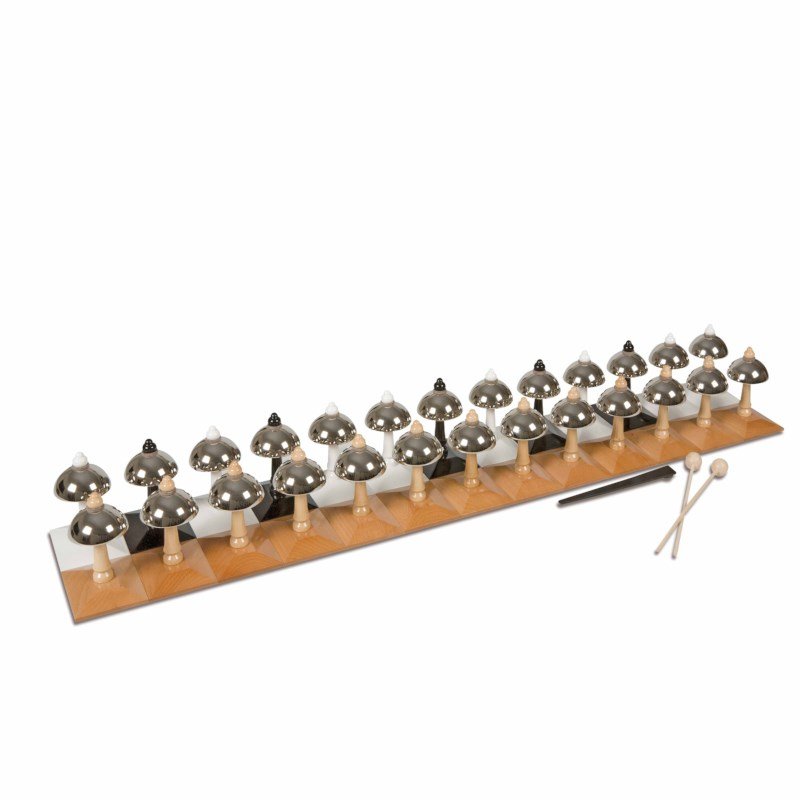Bells ~ Audio Sense
Material
Eight pairs of bells of the major scale beginning on middle C (do).
The stands of one set are white and the other set naturally varnished.
A mallet and a damper.
Two color coded boards representing the piano keyboard upon which to arrange the bells in order.
Materials:
Eight pairs of bells of the major scale beginning on middle C (do).
The stands of one set are white and the other set naturally varnished.
A mallet and a damper.
Two color coded boards representing the piano keyboard upon which to arrange the bells in order.
Direct Aim:
Auditory discrimination of sounds.
Indirect Aim:
Preparation for music.
Introduction:
These introductions are not all done on the same day. Depend on the child’s interest.
How to carry a bell:
Using the dominant hand, hold the stem of the bell and lift, placing the non-dominant hand under the base for support.
How to use the mallet:
Held vertically in the dominant hand by the fingertips at end of the handle, swing the bulb of the mallet gently towards the bell, hitting close to the rim for the best sound.
How to use the damper:
Held in the non-dominant hand, place the felt on the rim of the bell to stop ringing.
Introduce the scale and sing the name:
Ring the bell with the mallet and sing the child’s name. Do this with each of the notes, singing the entire scale.
Presentation:
Choose three brown bells and place them at random at the front of the shelf.
Use the mallet to ring the white bell on the board that is missing its match. Dampen the sound.
Isolate one of the three brown bells and ring to match the note of the white bell. Dampen sound and continue checking in this way until same bell is found.
When match is found, set mallet and damper on table and replace brown bell on board in front of the white bell. Check the bells.
Continue in this manner until other the two other bells are paired and replaced.
Invite the child to do the activity on his own.
Exercises:
Exercise 1 – Child’s own activity as shown in the presentation.
Exercise 2 – Pairing all bells.
Increase number of brown bells until child has all bells mixed. Pair bells in same manner as in presentation.
Exercise 3 – Grading the bells.
-Take all the brown bells off the stand and mix them up.
-Ring the first white bell to determine the first note and find it’s match from among the brown bells. Place bell in the first spot on the board. Check.
-Find the D note by ringing the brown bells, comparing to the C note. When the D is found, replace bell on board next to C bell.
-Continue grading in this manner until all bells are graded and replaced on the board.
-In the end, play up the brown bells and down the white bells to check.
Control of Error:
The control of error lies in the white bells.
The control of error in pairing and grading the bells lies in the child’s own perception.
Language:
The following language is offered by means of a Three Period Lesson:
Names of the notes in the scale appropriate to culture-
C D E F G A B C (names sung)
Do Re Me Fa So La Ti Do (names sung)
The quality of the notes are given as:
High-Low
Comparatives and superlatives of each of the above.
Age:
3 ½ to 4 years old – after the child has had practice with the sound boxes.
Games:
Game 1 – Pairing at a distance.
Move the brown bells carefully to an established spot far from the white bells and pair.
Game 2 – Grading at distance.
Ensure bells are mixed up well before the game starts.
Game 3a – higher - lower
Game 3b – just higher – just lower
Game 4 – Pairing in a group.
Invite sixteen children that have knowledge of the bells and have had practice with them to each hold a bell and a stick. Have the children mix randomly about the room. When they are thoroughly mixed, invite them to find the other child that has a bell matching their own. When the children have found their pair, have them stand two by two, and check bells for the same note.
Game 5 – Grading in a group.
Can be done with eight or sixteen children. Invite the children that have knowledge of the bells and have had practice with them to each hold a bell and a stick. Have the children mix randomly about the room. When they are thoroughly mixed, invite them to grade themselves according to the notes of the bells from highest to lowest or vice versa. When the children are arranged with their graded bells, ring each of the bells in order to check gradation.
Note:
The bells are a musical instrument called a sistry (percussion instrument used in many early musical compositions). It is an instrument that is extremely difficult to make and should be looked after carefully. Never polish them, only dusting with a soft cloth, and express the care with which they should be handled and treated with to the children.Direct Aim
Visual discrimination of differences - 1 dimensions
Indirect Aim
Preparation for Mathematics; length
Refinement of the voluntary movement
Age
Starting at 3.5yr
How to hold
There are 2 ways to carry the red
Hold the rod vertically, with both hands grasped around the rod place above and below the middle.
Hold the rod horizontally, with hands grasped on the ends
Presentation
Show the child how to pick up a rod and place it back on the shelf then invite the child to pick it up and take it to the mat
Bring the rods one at a time and place them at random on the mat.
Isolate the longest rod by placing it at the top of the mat
Using two fingers trace the entire length of the rod from left to right.
look for the next longest rod and place it carefully against the already positioned rod, so that the left side are inline
Run you hand down the left side to make sure the rod are alined.
With two fingers trace the entire length of the rod from left to right.
Continue to build the red rods in the same wayS
Occasional compare the size of the chosen rod with the next one of similar size.
Dismantle the red rods one at a time carefully and then invite the child to work with them.
Dismantle one at a time and then invite the child to build
Once you see the child is finishing or losing interest show them how to put the prism away in the same way as you took them out.
Roll up the mat and put it away.
The child activity is as shown in the presentation.
Follow up Exercises
Showing the unit of difference.
Showing the child the unit of difference.
After the child has arranged the red rod out in form.
Take the shortest rod and place it carefully against the end of each excessive rod. This show that each rod is different by the shortest rod.
Control of Error
The child's visual perspective.
Language
The following language are offered by means of the three-period lesson. Once the child has had a good experience with that rod:
long - short
Comparatives and superlatives of each of the above.
Games
Game 1 - building at a distance
Take 2 mats and place them on the opposite side of your room.
Put all the prism on one of the mats.
Find the thickest prism and carry it to the other mat.
Continue in this way until the stairs are built on the other mat.
This game can be started together and then the child can continue on their own
Game 2a - Thicker and Thinner
Take 2 mats and place them on the opposite side of your room.
Put all the prism on one of the mats.
Find the thickest prism and carry it to the other mat.
Ask the child to find a prism that is thinner than the prism on the mat
When the child brings you a different prism place it on the mat next to the thickest prism and compare.
Move the thickest prism to the side of the mat so the other prism is only in view.
Ask the child to find a prism that is thinner that the one on the mat.
Continue in this way asking for either a thicker or a thinker prism each time.
Game 2b - play in the same way as Game 2a, but using the language Just larger and Just smaller
Language
The following language is offered by means of the three-period lesson. Once the child has had a good experience with building the stairs.
Thick - Thin
Comparatives and superlatives; Thinker - thickest, Thinner - Thinnest

